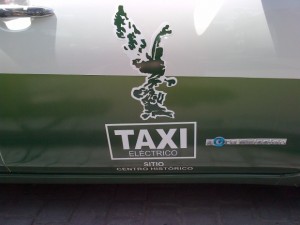Mexico City powers up electric taxi service
 MEXICO CITY – Green and white taxis pull up to their stand behind the capital’s towering cathedral. Then they plug in.
MEXICO CITY – Green and white taxis pull up to their stand behind the capital’s towering cathedral. Then they plug in.A pilot program is testing the viability of zero-emissions electric taxi service in Mexico City, notorious for its choking traffic and cough-inducing smog. The city laid out 11 million pesos, or $770,000, for 20 electric Nissan “Leaf” sedans. Service started earlier this month at the sitio, or stand, in the city’s historic center.
It’s the latest initiative in Mayor Marcelo Ebrard’s mobility strategy, which has included building out the city’s rapid-transit Metrobus service, adding a new metro line, replacing antiquated peseros with lower emissions buses, and starting a fast-growing bike lending program called Ecobici.
“It’s a public investment that seeks to generate examples and models for using new technologies,” said Inti Muñoz, director of the city’s Historic Center Trusteeship.
Every single taxi speeding down Mexico City’s wide avenues emits 14.8 tons of carbon dioxide per year, Muñoz said. The city’s mobility strategies, including the electric taxis initiative, have reduced the number of vehicles circulating by 20,000 per day to 50,000 daily.
That’s helped the city cut greenhouse gas emissions by 30 percent, Muñoz said.
Taxis 4000, a division of Mexico’s Grupo Publica that provides traditional tax service in the city, is running the electric taxi stand. (Grupo Publica also has public contracts to operate city buses, school buses, and light rail stations.)
Aguascalientes, capital of the Mexican state of the same name and home to the Nissan factory assembling the Leaf, was the first to launch an electric taxis program with 50 vehicles in May. It was a nod to a company that has been a repeat benefactor. Earlier this year, the Japanese automaker announced a 2 billion-peso investment (US$140 million) to construct a second assembly plant in Aguascalientes by 2013.
 The taxis turn heads at the Mexico City stand as passersby check out the two charging stations, each bearing a General Electric logo. A couple waits in the shade of the stand’s roof, outfitted with solar cells that provide 30 percent of the power for the charging stations.
The taxis turn heads at the Mexico City stand as passersby check out the two charging stations, each bearing a General Electric logo. A couple waits in the shade of the stand’s roof, outfitted with solar cells that provide 30 percent of the power for the charging stations.Muñoz noted that the technology is still too expensive to catch on in a massive way, given that an electric taxi stand costs about double a traditional one.
(Taxi service in Mexico City is a complex affair. “Sitio” taxis charge a bit more and are considered safer; legal and jitney private car services run the gamut of pricing; “street” taxis are exceedingly cheap by U.S. standards but, despite being regulated, are considered riskier. The electric taxis are priced like regular sitio cabs.)
With just 20 electric taxis operating for now, the stand is often empty, leaving impatient travelers better off hailing a cab on the next corner.
You can return to the main Market News page, or press the Back button on your browser.

